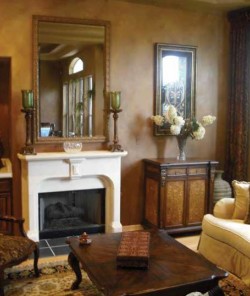Faux Real!
Paint designer Amy Rikhoff has mastered the art of illusion.
 When it comes to replicating textures and colors, there’s nothing that Amy Rikhoff can’t do. “I refer to myself as a paint designer,” says Rikhoff, who creates custom faux finishes through her company, FAUXshiggidy. “I’m mixing stuff all the time, from oil paint to latex to different products.”
When it comes to replicating textures and colors, there’s nothing that Amy Rikhoff can’t do. “I refer to myself as a paint designer,” says Rikhoff, who creates custom faux finishes through her company, FAUXshiggidy. “I’m mixing stuff all the time, from oil paint to latex to different products.”
The name FAUXshiggidy comes from Rikhoff’s long tenure in the restaurant industry. “I cooked professionally for over 10 years,” she says.
Though she left the chef’s life behind more than a decade ago, Rikhoff never forgot the way one of her kitchen colleagues would answer her requests to do something: “Fo’shiggidy,” a slang term meaning “For sure.” “That word just kind of stuck with me,” she says.
Rikhoff began experimenting with faux finishes in her 20s, teaching herself how to create the appearance of wood, marble, plaster and other finishes with just a paintbrush and paint. While living in Florida, she began painting metal doors to look like wood — a technique that saved homeowners the hassle of sanding, re-staining and re-finishing doors every few years. “The sun would just destroy the [wooden] front doors,” Rikhoff says. “It really doesn’t cost any more or less to do a faux finish versus sanding [a door] down or staining it. I guarantee my work, and I want it to last for a long time.”
About a quarter of Rikhoff’s business involves “wood-graining.” She also custom-paints and stencils walls, furniture and floors. “Distressed, wood-graining, color washes, stencils and marbling are the finishes I practice the most,” she says. “I can pretty much do anything. If somebody shows me a picture, I can pretty much replicate it.” Having worked with numerous restaurants and businesses, Rikhoff is able to suggest economical industrial finishes.
Rikhoff also offers color-consulting services — from helping knowledgeable homeowners pick their favorite shades, to guiding those totally baffled by the floor-to-ceiling color design process. “I pick out colors, and mix up special stains for people’s floors,” she says. “It gives them something different.”
For would-be painters, Rikhoff offers a weeklong faux-finishing class. “It’s really good for people who might want to do it for their own home or start a business,” she says.
FINISHING UP
Work your own home improvement magic with Rikhoff’s painting and finishing tips.
Avoid white ceilings. “I love wallpaper on the ceilings, or a bold, monochromatic damask stencil to make a room with solid-colored walls pop,” Rikhoff says. “Ceilings, to me, are just as important as walls, and can add texture and elegance without a lot of flash.”
Save neutrality for the Internet. “I mix a lot of neutrals into faux finishes, but I avoid a lot of buff hues that could come out looking like Band-Aid colors on the wall. Try to pick something with a few more gold or red undertones, if in doubt.”
Go dark. “I avoid picking the lightest colors on the paint swatches. If you refrain from putting pure whites in your color scheme, it will translate into a more sophisticated color palette. The myth that dark colors make rooms smaller should be buried forever!”
Don’t stress. Paint doesn’t need to be permanent — so it’s okay if family members can’t agree on a shade. “Fighting over a color is never worth it,” Rikhoff says. “It is just paint, and [it] can be replaced in a few years without a major face-lift.”
Do your research. “When I started faux-finishing, I would sit in Barnes & Noble poring over finishing books, and that is where I learned a lot of what I know,” Rikhoff says. Anyone thinking about building or remodeling a home can do the same, especially if two or more people are involved in the process. “Not everything is on Pinterest, although it is a great resource,” she says.
